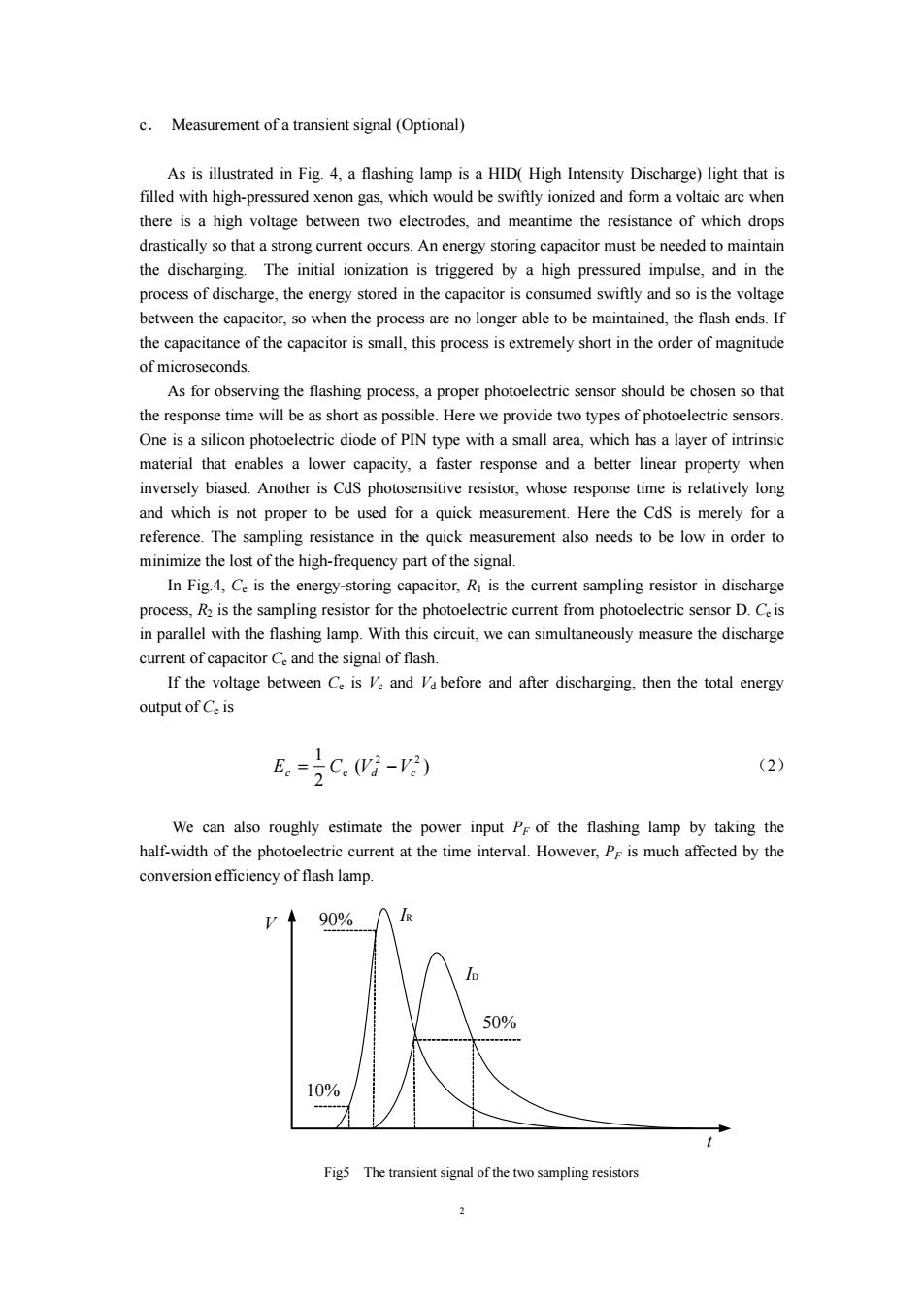正在加载图片...

c.Measurement of a transient signal (Optional) As is illustrated in Fig.4,a flashing lamp is a HID(High Intensity Discharge)light that is filled with high-pressured xenon gas,which would be swiftly ionized and form a voltaic arc when there is a high voltage between two electrodes,and meantime the resistance of which drops drastically so that a strong current occurs.An energy storing capacitor must be needed to maintain the discharging.The initial ionization is triggered by a high pressured impulse,and in the process of discharge,the energy stored in the capacitor is consumed swiftly and so is the voltage between the capacitor,so when the process are no longer able to be maintained,the flash ends.If the capacitance of the capacitor is small,this process is extremely short in the order of magnitude of microseconds. As for observing the flashing process,a proper photoelectric sensor should be chosen so that the response time will be as short as possible.Here we provide two types of photoelectric sensors. One is a silicon photoelectric diode of PIN type with a small area,which has a layer of intrinsic material that enables a lower capacity,a faster response and a better linear property when inversely biased.Another is Cds photosensitive resistor,whose response time is relatively long and which is not proper to be used for a quick measurement.Here the Cds is merely for a reference.The sampling resistance in the quick measurement also needs to be low in order to minimize the lost of the high-frequency part of the signal. In Fig.4,Ce is the energy-storing capacitor,R is the current sampling resistor in discharge process,R2 is the sampling resistor for the photoelectric current from photoelectric sensor D.Ce is in parallel with the flashing lamp.With this circuit,we can simultaneously measure the discharge current of capacitor Ce and the signal of flash. If the voltage between Ce is Ve and Va before and after discharging,then the total energy output of Ce is E.-c.- (2) We can also roughly estimate the power input Pr of the flashing lamp by taking the half-width of the photoelectric current at the time interval.However,Pr is much affected by the conversion efficiency of flash lamp. 90% 50% 10% Fig5 The transient signal of the two sampling resistors 22 c. Measurement of a transient signal (Optional) As is illustrated in Fig. 4, a flashing lamp is a HID( High Intensity Discharge) light that is filled with high-pressured xenon gas, which would be swiftly ionized and form a voltaic arc when there is a high voltage between two electrodes, and meantime the resistance of which drops drastically so that a strong current occurs. An energy storing capacitor must be needed to maintain the discharging. The initial ionization is triggered by a high pressured impulse, and in the process of discharge, the energy stored in the capacitor is consumed swiftly and so is the voltage between the capacitor, so when the process are no longer able to be maintained, the flash ends. If the capacitance of the capacitor is small, this process is extremely short in the order of magnitude of microseconds. As for observing the flashing process, a proper photoelectric sensor should be chosen so that the response time will be as short as possible. Here we provide two types of photoelectric sensors. One is a silicon photoelectric diode of PIN type with a small area, which has a layer of intrinsic material that enables a lower capacity, a faster response and a better linear property when inversely biased. Another is CdS photosensitive resistor, whose response time is relatively long and which is not proper to be used for a quick measurement. Here the CdS is merely for a reference. The sampling resistance in the quick measurement also needs to be low in order to minimize the lost of the high-frequency part of the signal. In Fig.4, Ce is the energy-storing capacitor, R1 is the current sampling resistor in discharge process, R2 is the sampling resistor for the photoelectric current from photoelectric sensor D. Ce is in parallel with the flashing lamp. With this circuit, we can simultaneously measure the discharge current of capacitor Ce and the signal of flash. If the voltage between Ce is Vc and Vd before and after discharging, then the total energy output of Ce is ( ) 2 1 2 2 Ec = Ce Vd −Vc (2) We can also roughly estimate the power input PF of the flashing lamp by taking the half-width of the photoelectric current at the time interval. However, PF is much affected by the conversion efficiency of flash lamp. V t IR ID 10% 90% 50% Fig5 The transient signal of the two sampling resistors